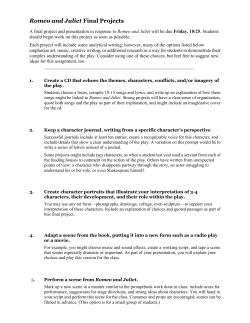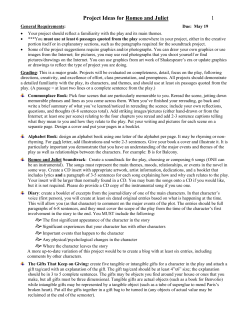
Review P
PHOSPHONATED ISOXAZOLIDINYL NUCLEOSIDES, A NEW CLASS OF MODIFIED NUCLEOSIDES Salvatore V. Giofrè 1, Roberto Romeo 1, Maria A. Chiacchio 2 SUMMARY This review offers an overview of the synthesis of phosphonated isoxazolidinyl nucleosides, a new class of interesting and potentially antiviral/antitumor agents. The synthetic methodology relies on a 1,3-dipolar cycloaddition reaction as a key step. The cycloaddition process involves substituted nitrones, phosphonated nitrones, or nitrones containing functional groups easily convertible into a phosphonated group. Biological assays are presented, which show that phosphonated isoxazolidinyl nucleosides represent a new promising template of nucleoside analogues. Introduction Modified nucleosides have received a great deal of attention in the search for new antiviral/anticancer agents.1-12 Many compounds have been described in literature; however, often, the clinical exploitation of most of the biologically active compounds is prevented by significant and undesirable side effects, and by different emerging problems such as tolerance, toxicity and cross-resistance. For this reason, a great research effort is still being dedicated to the design and development of new nucleoside analogues endowed with improved efficiency and reduced side effects. With regard to this, structural modifications have been performed with respect to natural nucleosides at the level of both the heterocyclic base and the sugar residue, such as a) the replacement of the C-N glycosidic bond with a hydrolytically stable C-C bond;13-18 b) the substitution of the ribose ring with an acyclic system; 19-21 c) the displacement of the oxygen atom of the ribose unit with a methylene group;22,23 d) the insertion of unnatural nucleobases;24,25 e) the replacement of the furanose ring with different heterocyclic systems. 26,27 In particular, the substitution of the sugar moiety with an isoxazolidine ring has allowed for the development of a new class of N,O-nuclosides, which have been shown to be endowed with important biological features.28-43 Most of the nucleoside analogues possessing antiviral activities rely upon specific phosphorylation by a virally encoded kinase.44 Of the three successive phosphorylation steps, the first is rate-limiting, while the conversion to di- and tri-phosphates, which interact with RT or interfere with cell growth, is catalyzed by less specific kinases. Consequently, a good delivery system for a nucleoside across cellular membranes is represented by the design of phosphate analogues, where the phosphate moiety is changed to isosteric and isoelectronic phosphonates, which mimic the nucleoside monophosphates, and are able Address of the authors 1. Dipartimento di Scienze del Farmaco e dei Prodotti per la Salute, Messina 2. Dipartimento di Scienze del Farmaco, Catania Send correspondence to: Salvatore V. Giofrè, sgiofre@unime.it Received: August 5th, 2014 — Revised: September 24th, 2014 — Accepted: October 9th, 2014 ISSN 2279-7165 - Euromediterranean Biomedical Journal [online] © EUROMEDITERRANEAN BIOMEDICAL JOURNAL 2014, 9(7):45-55. DOI: 10.3269/1970-5492.2014.9.7 Available on-line at: http://www.embj.org Review EMBJ, 9(7), 2014 — www.embj.org PHOSPHONATED ISOXAZOLIDINYL NUCLEOSIDES, p.46 to bypass the initial selective enzymatic monophosphorylation step. The purpose of this review is to give an overview of the synthesis of phosphonated isoxazolidinyl nucleosides, with particular focus on the biologically interesting compounds, covering the recent literature. Synthetic approach to Phosphonated Isoxazolidinyl Nucleosides Phosphonated isoxazolidinyl nucleosides can be classified in different groups depending on the relative position of the nucleobase and the phosphonated moiety (Figure 1). Compounds of structure I. Truncated phosphonated N,O-nucleosides (I), containing a diethylphosphonate group directly linked at C-3 of the isoxazolidine ring, have been synthesized by Romeo and Chiacchio’s group.45 These compounds were obtained, starting from the phosphonated nitrone 1, according to two different routes. Route a) involves the reaction of 1 with vinyl nuleobases, under microwave irradiation, and leads to the -nucleosides 2 as main adducts (58-60%); route b), on the contrary, produces the -anomers 3 as main products in 42-45% overall yield, by a two-step procedure involving the 1,3dipolar cycloaddition of nitrone 1 with vinyl acetate and the subsequent Vorbrüggen nucleosidation (Scheme 1). A modification of this series of compounds is represented by the insertion of an alkoxy carbonyl group at the anomeric Figure 1: Phosphonated isoxazolidinyl nucleosides Scheme 1 EMBJ, 9(7), 2014 — www.embj.org GIOFRE’ ET AL., p.47 center of the isoxazolidine ring to produce the so called phosphonated C-1-branched N,O-nucleosides.46 These nucleosides are synthesized by reaction of the phosphonated nitrone 1 with ethyl 2acetyloxyacrylate, followed by the usual Vorbrüggen procedure.47 The cycloaddition approach produces a mixture of trans/cis isoxazolidines 5 and 6 in an isomeric ratio of 4.5:1 and a global yield of 80%. The subsequent condensation with silylated thymine, uracil or acetylcytosine affords and anomers 7 and 8 in a 2:3 relative ratio, while, with silylated 5-fluorouracil, the anomer 8 is almost the only compound (Scheme 2). Compounds of structure II These compounds are considered mimetic of monophosphate nucleosides and contain a diethylphosphonate group linked at C-3’ of the isoxazolidine ring.48 Their synthesis involves the 1,3-dipolar cycloaddition of the phosphonated nitrone 9 with vinyl acetate, with formation of a mixture of epimeric isoxazolidines 10 and 11. Their independent coupling with silylated nucleobases affords phosphonated N,Onucleosides 12 and 13. The anomeric distribution of 12 and 13 is dependent on the nucleobase used. With 5-fluorouracil, the anomer is almost the only product, while, with thymine and N-acetylcytosine, a sig- Scheme 2 Scheme 3 EMBJ, 9(7), 2014 — www.embj.org PHOSPHONATED ISOXAZOLIDINYL NUCLEOSIDES, p.48 nificant amount of the anomer has been obtained (Scheme 3).49 A successful implementation of the synthetic scheme, leading to phosphonated N,O-nucleosides 12 and 13, has been achieved starting from the C-[(tertbutyldiphenylsilyl)oxy]-N-methylnitrone 14, and proceeds in five steps. In the first step, the nitrone 14 is reacted with vinyl acetate affording a mixture of epimeric isoxazolidines 15 and 16 (Scheme 4) in a relative ratio of 1:4.2 (global yield 90%). In the second step, the crude mixture of isoxazolidines is nucleosidated with purine or pyrimidine nucleobases, to give nucleosides 17 and 18, in acetonitrile at 50-60 ° C, in presence of trimethylsilytriflate as catalyst. In these conditions, the stereochemical outcome of the nucleosidation process depends on the nucleobase. Thus, with purine nucleobases, a mixture of and anomers in a 2:3 relative ratio has been obtained, while, a better stereoselection in favour of anomers occurs when pyrimidine nucleobases are used ( = 3:7). Finally, the targets N,O-nucleosides 12 and 13 have been obtained from nucleosides 17 and 18 in three consecutive reactions: a) desilylation; b) tosylation; c) Arbuzov reaction.50 Compounds of structure III The synthetic approach leading to compounds of structure III, which contain the phosphonate group linked at C-3” of the isoxazolidine ring, exploits the 1,3-dipolar cycloaddition reaction of nitrone 19. This compound (E/Z mixture, 85% yield) is prepared from the commercially available 3chloro propanaldehyde diethyl acetal by reaction with triethyl phosphite, acidic hydrolysis to the corresponding phosphonated aldehyde, and reaction with Nmethyl hydroxylamine. The nitrone 19, thus obtained, is converted into the target compounds 22 and 23, by treatment with vinyl acetate and subsequent coupling with silylated nucleobases.47 The anomers 23 have been obtained in higher yields with respect to anomers 22, in a ratio varying from 9:1 (N-acetylcytosine) to 7:3 (thymine Scheme 4 EMBJ, 9(7), 2014 — www.embj.org GIOFRE’ ET AL., p.49 and 5-fluorouracil). The N-acetylcitosine derivatives 23c have been further deacetylated to 23d by treatment with 5% aqueous sodium carbonate.51 Compounds of structure IV, V and VI The development of synthetic strategies aimed at the preparation of new phosphonated N,O-nucleoside analogues has also been investigated by Piotrowska and coworkers. In particular, phosphonated N,Ohomonucleosides, phosphonated N,Onucleotide analogues with a 1,2,3-triazole linker, and phosphonated N,O-nucleotide analogues with a carbamoyl linker were synthesized.52,53 Phosphonated N,O-homonucleosides (Structures IV) were prepared according to two synthetic approaches. The first leads to the formation of N,O-homonucleosides having the nucleobase at C-3’, with the phosphonic group linked at the C-5 position, while the second one affords N,Ohomonucleosides containing the phosphonic group at C-5’ of the isoxazolidinic ring.54 The 1,3-dipolar cycloaddition of nitrone 24 with diethyl vinyl-, and dietyl allylphosphonate was performed under microwave irradiation to produce a cis/trans mixture Scheme 5 Scheme 6 EMBJ, 9(7), 2014 — www.embj.org PHOSPHONATED ISOXAZOLIDINYL NUCLEOSIDES, p.50 of diastereoisomeric isoxazolidines. When diethyl vinylphosphonate was used, a 64:36 mixture of isoxazolidines 25 and 26 in 30% yield was obtained. The cycloaddition with diethyl allylphosphonate affords an 80:20 mixture of isoxazolidines 27 and 28 in 24% yield. (Scheme 6). Reversed phosphonated N,Ohomonucleosides, in which the phosphonate group is linked at C-3, while the heterocyclic bases are linked at C-5 of isoxazolidine ring, have also been reported (Structures V).55 The 1,3-dipolar cycloaddition of the phosphonated nitrone 1 with Nallylnucleobase was carried out in thermal conditions in a single solvent or in a solvents mixture, depending on the solubility of the respective N-nucleobase, to afford a mixture of diastereoisomeric phosphonated N,O-homonucleosides 29 and 30 in good to excellent yield, with low to moderate trans/cis diastereoselectivity (Scheme 7). In this regard, a new class of phospho- nated N,O-nucleotide analogues, characterized by the presence of a 1,2,3-triazole linker, was synthesized (Structures VI). The new compounds present the 1,2,3-triazole linker between the isoxazolidine spacer and the purine/pyrimidine nucleobase.56 The synthetic approach was based on the preparation of 5-azidoisoxazolidines 31 and 32, in 1:1 anomeric mixture, from 5acetoxyisoxazolidines 4 by reaction with TMSN3, and further transformation of the azides into the respective nucleoside mimetics by a click chemistry process.57,58 (Scheme 8). Piotrowska and co-workers have also investigated the synthesis and the biological activity of a new series of phosphonated 5(arylcarbamoyl)-isoxazolidines, with a carbamoyl linker between the isoxazolidine spacer and the purine/pyrimidine nucleobase or other aromatic compounds as nucleobase replacers.52,53 The synthetic method exploits the 1,3dipolar cycloaddition of the nitrone 1 with Scheme 7 Scheme 8 EMBJ, 9(7), 2014 — www.embj.org GIOFRE’ ET AL., p.51 substituted acrylamides 35, which have been synthesized from commercially available substituted anilines and acryloyl chloride in the presence of triethylamine.57,58 The cycloaddition reaction is carried out in toluene at 70°C and affords mixtures of diastereoisomeric trans/cis phosphonated 5-(arylcarbamoyl)-isoxazolidine 36 and 37 with a 50-80% diastereoselectivity. Biological Properties of Phosphonated Isoxazolidinyl Nucleosides Biological assays performed on the series of compounds I, indicate that -anomers 3 completely inhibit the RT of Avian Moloney Virus (AMV) and Human Immunodeficiency Virus (HIV), at concentrations 1±0.1 nM, at a level comparable with that of tenofovir (1nM) and 10-fold lower than AZT (10 nM). Moreover, MTS assays have indicated a very low toxicity (CC50 > 500 μM) in comparison with AZT (CC50 12.14 μM).45 Biological assays performed on the anomers 8, indicated that these compounds are able to inhibit the RT of AMV, HTLV-1 and HIV. In particular, the 5fluorouracil derivative is shown to be the most promising derivative, acting on AMV and on HIV at concentration 1 and 10nM, respectively. The level of the inhibitory activity towards HTLV-1 and HIV was 10fold higher than that of tenofovir and similar to that of AZT. Moreover, this compound does not show any cytoxicity according to MTS assays. Also, biological properties of the series of compounds II have been evaluated. In particular, the cytotoxicity and the RTinhibitory activity of -anomers 12 were investigated. These compounds show low levels of cytotoxicity, assessed by conventional methods to detect viability. Noteworthy, the synthesized N,O- phosphonated nucleosides were as powerful as AZT in inhibiting the RT activity of the human T-cell leukemia/lymphotropic virus type 1 and in protecting human peripheral blood mononuclear cells against human T-cell leukemia/lymphotropic virus type 1 transmission in vitro.49,50 All the compounds of structure III have been evaluated for their ability to inhibit RT of avian myeloblastosis retrovirus, but no significant antiviral activity was observed.51 The lack of antiviral activity in this class of compounds can be inferred from the considerations reported by Sigel.60,61 Chelation with metal ions seems to play a determinant role: viral polymerases recognize and use triphosphate nucleosides, complexed with metal ions ( Mg++ and Mn++). The type of complexation determines the reaction pattern of nucleotides. Thus, for phosphonated N,Onucleosides, the proximity of the N- atom to P- atom appears to be determinant for the biological activity. In full length nucleotides 23, the N atom cannot make a certain contribution because a 7-membered ring should be formed by chelation, while short length and truncated PCOAN could form 6six or 5-membered chelates, thus facilitating the bond break between P- and P- and allowing the transfer of the nucleotide group with release of pyrophosphate. Phosphonated N,O-homonucleosides, (structure V) resulting from the cycloaddition with N-allylnucleobases, were screened for activity against a variety of DNA and RNA viruses; the compounds have been found to be non-toxic up to a concentration of 250 μM. Proliferation inhibitory effect on murine leukemia (L1210), human T-lymphocyte (CEM) and human cervix carcinoma cells (HeLa) was detected with an IC50 in the 33-192 μM Scheme 9 EMBJ, 9(7), 2014 — www.embj.org PHOSPHONATED ISOXAZOLIDINYL NUCLEOSIDES, p.52 range. For the series of compounds of structure VI, no inhibitory activity against any virus was shown at 250 μM. Derivatives in which the nucleobase was replaced by an aromatic system are endowed with a 50% cytostatic concentration (CC50), against murine Leukemia L1210, human lymphocyte CEM, human cervix carcinoma Hela and human lung fibroblast HEL cells, in the range of 40-250 μM. Cytostatic activity, of derivatives of phosphonated 5-(arylcarbamoyl)-isoxazolidines 36 and 37, with a carbamoyl linker, was measured on three tumor cell lines (L1210, CEM and HeLa). An IC50 above 100 μM was shown. Conclusions In this review, the reported synthetic approaches to regard to phosphonated N,Onucleoside analogues have been summarized. The key step of the synthetic process is the 1,3-dipolar cycloaddition reaction of suitably substituted nitrones with functionalized dipolarophiles. Better results were obtained through the use of microwave irradiation compared to classical thermal conditions. The potential antiviral and anticancer activities of phosphonated N,O-nucleosides have been examined. Biological tests show that some of these derivatives are able to inhibit the infection of HIV or HTLV-1 viruses, while the derivatives in which the natural nucleobase has been replaced with heteroaromatic systems are able to inhibit cell proliferation of different tumor cell lines. The obtained results show that phosphonated N,O-nucleosides represent a promising new template of nucleoside analogues which deserve further investigation as lead compounds for the preparation of potent inhibitors of biological targets. References 1.Chu CK. In Recent Advances in Nucleosides: Chemistry and Chemotherapy. Ed. Elsevier Science: New York, 2002. 2.Takahashi T, Shimizu M, Akinaga S. Mechanisms of the apoptotic activity of ClF-araA in a human T-ALL cell line, CCRFCEM. Cancer Chemother. Pharmacol. 2002, 50, 193–201. 3.Miura S, Izuta S. DNA Polymerases as Targets of Anticancer Nucleosides. Current Drug Targets, 2004, 5, 191–195. 4.Thottassery JV, Westbrook L, Someya H, Parker W B. c-Abl-independent p73 stabilization during gemcitabine- or 4′-thio-β-Darabinofuranosylcytosine–induced apoptosis in wild-type and p53-null colorectal cancer cells. Mol. Cancer Therapeut., 2006, 5, 400–410. 5.Lebeau I, Andrei G, Krecmerova M, De Clercq E, Holy A, Snoeck R. Inhibitory Activities of Three Classes of Acyclic Nucleoside Phosphonates against Murine Polyomavirus and Primate Simian Virus 40 Strains. Antimicrob. Agent Chemother. 2007, 51, 2268–2273. 6.Hishitsuka H, Shimma N, Herdewijn P. In Modified Nucleosides in Biochemistry, Biotechnology and Medicine. Ed. Wiley, 2008, p 587-600. 7.Parker WB. Enzymology of Purine and Pyrimidine Antimetabolites Used in the Treatment of Cancer. Chem. Rev. 2009, 109, 2880–2893. 8.De Clercq E. The history of antiretrovirals: key discoveries over the past 25 years. Rev. Med. Virol. 2009, 19, 287–299. 9.Cihlar T, LaFlamme G, Fisher R, Carey A C, Vela J E, Mackman R, Ray A S. Novel Nucleotide Human Immunodeficiency Virus Reverse Transcriptase Inhibitor GS-9148 with a Low Nephrotoxic Potential: Characterization of Renal Transport and Accumulation. Antimicrob. Agents Chemother., 2009, 53, 150–156. 10.Vanek V, Budesinsky M, Rinnova M, Rosemberg, I. Prolinol-based nucleoside phosphonic acids: new isosteric conformationally flexible nucleotide analogues. Tetrahedron, 2009, 65, 862–876. 11.Kumamoto H, Topalis D, Broggi J, Pradere U, Roi V, Berteina-Raboin S, Nolan SP, Deville,-Bonne D, Andrei G, Snoeck R, Garin D, Grance GM, Agrofoglio LA- Preparation of acyclo nucleoside phosphonate analogues based on cross-metathesis. Tetrahedron, 2008, 64, 3517–3526. 12.Vrbkova S, Dracinsky M, Holy A. Synthesis of phosphonomethoxyethyl or 1,3-bis (phosphonomethoxy)propan-2-yl lipophilic esters of acyclic nucleoside phosphonates. Tetrahedron, 2007, 63, 11391–11398. 13.Elgemeie GH, Zaghary WA, Amin KM, Nasr TM. New Trends in Synthesis of Pyrazole Nucleosides as New Antimetabolites. Nucleosides, Nucleotides & Nucleic Acids, 2005, 24, 1227–1247. 14.Mironiuk-Puchalska E, Koszytkowska- EMBJ, 9(7), 2014 — www.embj.org Stawinska M, Sas W, De Clercq E, Naesens L. Synthesis of Novel AZA-Analogues of Tiazofurin with 2-[5,5-bis(Hydroxymethyl) Pyrrolidin-2-yl] Framework as Sugar Mimic. Nucleosides, Nucleotides & Nucleic Acids 2012, 31, 72–84. 15.Merino P, Tejero T, Unzurrunzaga FJ, Franco S, Chiacchio U, Saita MG, Iannazzo D, Piperno A, Romeo G. An efficient approach to enantiomeric isoxazolidinyl analogues of tiazofurin based on nitrone cycloadditions. Tetrahedron: Asimmetry, 2005, 16, 3865–3876. 16.Chiacchio U, Rescifina A, Saita MG, Iannazzo D, Romeo, G, Mates JA, Tejero T, Merino P. Zinc(II) Triflate-Controlled 1,3Dipolar Cycloadditions of C-(2-Thiazolyl) nitrones: Application to the Synthesis of a Novel Isoxazolidinyl Analogue of Tiazofurin. J. Org. Chem. 2005, 70, 8991–9001. 17.Franchetti P, Cappellacci L, Perlini P, Jayaram HN, Butler A, Schneider BP, Collart FR, Huberman E, Grifantini M. Isosteric Analogues of Nicotinamide Adenine Dinucleotide Derived from Furanfurin, Thiophenfurin, and Selenophenfurin as Mammalian Inosine Monophosphate Dehydrogenase (Type I and II) Inhibitors. J. Med. Chem. 1998, 41, 1702–1707. 18.Franchetti P, Cappellacci L, Marchetti S, Martini C, Costa B, Varani K, Borea PA, Grifantini M; c-nucleoside analogues of furanfurin as ligands to a1 adenosine receptors. Bioorg. Med. Chem. 2000, 8, 2367–2373. 19.Hirota K, Monguchi Y, Sajiki H, Chu C. In Recent Advances in Nucleosides. K. Ed., 2002, p 57–70. 20.El Ashry ESH, Rashed N. Carbohydrate Hydrazones and Osazones as Organic Raw Materials for Nucleosides and Heterocycles. Curr. Org. Chem. 2000, 4, 609–651. 21.Littler E, Zhou XX, Taylor, John B, Triggle DJ. In Comprehensive Medicinal Chemistry II. J. Eds., 2006, 7, p 295–327. 22.Wang J, Rwal RK, Chu CK, Zhang Li-He, Xi Zhen, Chattopadhyaya. In Medicinal Chemistry of Nucleic Acids. J. Eds., 2011, p 1–100. 23.Gundersen L; Metal-mediated C-C and C -N bond formation in the synthesis of bioactive purines. Targets in Heterocyclic Systems, 2008, 12, 85–119. 24.Riley TA, Larson SB, Avery TL, Finch R A, Robins RK; 1,2,4-Diazaphosphole nucleosides. Synthesis, structure, and antitumor activity of nucleosides with GIOFRE’ ET AL., p.53 a.lambda.3 phosphorus atom. J. Med. Chem, 1990, 33, 572–576. 25.Wang P, Hollecker L, Pankiewicz KW, Patterson SE, Whitaker T, Mc Brayer TR, Thzarnish P M, Sidwell R W, Styver L J, Otto M J, Schinazi R F, Watanabe K A; Synthesis of N3,5‘-Cyclo-4-(β-d-ribofuranosyl)-victriazolo[4,5-b]pyridin-5-one, a Novel Compound with Anti-Hepatitis C Virus Activity. J. Med. Chem. 2004, 47, 6100–6103. 26.Romeo G, Chiacchio U, Corsaro A, Merino P. Chemical Synthesis of Heterocyclic−Sugar Nucleoside Analogues. Chem. 27.Merino P. Heterocyclic Nucleosides: Chemical Synthesis and Biological Properties. Curr. Med. Chem. 2006, 13, 539–545. 28.Chiacchio U, Corsaro A, Iannazzo D, Piperno A, Procopio A, Rescifina A, Romeo G. A Stereoselective Approach to Isoxazolidinyl Nucleosides. Eur. J. Org. Chem., 2001, 10, 1893-1898. 29.Chiacchio U, Corsaro A, Pistarà V, Rescifina A, Iannazzo D, Piperno A, Romeo G, Romeo R, Grassi G. Diastereoselective Synthesis of N,O-Psiconucleosides, a New Class of Modified Nucleosides. Eur. J. Org. Chem., 2002, 7, 1206-1212. 30.Saita M G, Chiacchio U, Iannazzo D, Corsaro A, Merino P, Piperno A, Previtera T, Rescifina A, Romeo G, Romeo R. Diastereoand Enantioselective Synthesis of 1′-CBranched N, O-Nucleosides. Nucleosides, Nucleotides and Nucleic Acids, 2003, 22, 739-742. 31.Chiacchio U, Corsaro A, Iannazzo D, Piperno A, Pistarà V, Rescifina A, Romeo R, Sindona G, Romeo G. Diastereo- and enantioselective synthesis of N,O-nucleosides. Tetrahedron Asymmetry, 2003, 14, 27172723. 32.Chiacchio U, Corsaro A, Iannazzo D, Piperno A, Pistarà V, Rescifina A, Romeo R, Valveri V, Mastino A, Romeo G. Enantioselective Syntheses and Cytotoxicity of N,ONucleosides. J.Med. Chem. 2003, 46, 36963702. 33.Chiacchio U, Corsaro A, Mates J, Merino P, Piperno A, Rescifina A, Romeo G, Romeo R, Tejero T. Isoxazolidine analogues of pseudouridine: a new class of modified nucleosides. Tetrahedron, 2003, 59, 47334738. 34.Chiacchio U, Genovese F, Iannazzo D, Librando V, Merino P, Rescifina A, Romeo R, Procopio A, Romeo G. Diastereoselective synthesis of homo-N,O-nucleosides. Tetra- EMBJ, 9(7), 2014 — www.embj.org PHOSPHONATED ISOXAZOLIDINYL NUCLEOSIDES, p.54 hedron, 2004, 60, 441-448. 35.Chiacchio U, Corsaro A, Iannazzo D, Piperno A, Romeo G, Romeo R, Saita MG, Rescifina A. Synthesis of Methyleneisoxazolidine Nucleoside Analogues by Microwave-Assisted Nitrone Cycloaddition Eur. J. Org. Chem. 2007, 28, 4758-4764. 36.Merino P, Tejero T, Matés J, Chiacchio U, Corsaro A, Romeo G. 3-(Aminomethyl)-2 -(carboxymethyl)isoxazolidinyl nucleosides: building blocks for peptide nucleic acid analogues. Tetrahedron Asymmetry, 2007, 18, 1517-1520. 37.Romeo G, Giofré SV, Piperno A, Romeo R, Chiacchio MA. Synthesis of N,Ohomonucleosides with high conformational freedom. Arkivoc, 2009, (viii) 168176. 38.Romeo R, Giofrè SV, Iaria D, Sciortino MT, Ronsisvalle S, Chiacchio MA, Scala A. Synthesis of 5-Alkynyl Isoxazolidinyl Nucleosides. Eur. J. Org. Chem. 2011, 5690– 5695. 39.Romeo R, Giofrè SV, Macchi B, Balestrieri E, Mastino A, Merino P, Carnovale C, Romeo G, Chiacchio U. Truncated Reverse Isoxazolidinyl Nucleosides. A New Class of Allosteric HIV-RT Inhibitors. ChemMedChem, 2012, 7, 565–569. 40.Romeo R, Giofrè SV, Garozzo A, Bisignano B, Corsaro A, Chiacchio MA. Synthesis and biological evaluation of furopyrimidine N,O-nucleosides. Bioorg. Med. Chem. 2013, 21, 5688–5693. 41.Romeo R, Giofrè SV, Carnovale C, Campisi A, Parenti R, Bandini L, Chiacchio MA. Synthesis and Biological Evaluation of 3-Hydroxymethyl-5-(1H-1,2,3-Triazol) Isoxazolidines. Bioorg. Med. Chem. 2013, 21, 7929-7937. 42.Romeo R, Giofrè SV, Carnovale C, Chiacchio Chiacchio MA, Campisi A, Mancuso R, Cirmi S, Navarra M. Synthesis and Biological Activity of Triazole-Appended N,ONucleosides. Eur. J. Org. Chem. 2014. 25, 5442-5447. 43.Romeo R, Carnovale C, Giofrè SV, Monciino G, Chiacchio MA, Sanfilippo C, Macchi B. Enantiomerically Pure Phosphonated Carbocyclic 2’-Oxa-3’-Azanucleosides: Synthesis and Biological Evaluation. Molecules 2014, 19, 14406-14416. 44.Wedemeyer H, Hardtke S, Cornberg M. Therapie der Hepatitis C. Chemotherapie Journal, 2012, 21, 1–7. 45.Piperno A, Giofrè SV, Iannazzo D, Romeo R, Romeo G, Chiacchio U, Rescifina A, Piotrowska DG. Synthesis of C4’Truncated Phosphonated Carbocyclic 2’Oxa-3’-azanucleosides as Antiviral Agents. J. Org. Chem. 2010, 75, 2798–2805. 46.Romeo R, Romeo G, Carnovale C, Giofrè SV, Macchi B, Frezza C, MerinoMerlo F, Pistarà V, Chiacchio U. Truncated phosphonated C-1'-branched N,Onucleosides: A new class of antiviral agents. Bioorg. Med. Chem. 2012, 20, 3652–3657. 47.Vorbrüggen JM, Kvolikiewicz K, Bennua B. Nucleoside syntheses, XXII Nucleoside synthesis with trimethylsilyl triflate and perchlorate as catalysts. Chem. Ber. 1981, 114, 1234–1255. 48.Perigaud C, Girardet J L, Gosselin G, Imbach J L, De Clercq R. Advances in Antiviral Drug Design. Ed. JAI Press: Greenwich, CT, 1995; Vol. 2, pp 167−172. 49.Chiacchio U, Balestrieri M, Macchi B, Iannazzo D, Piperno A, Rescifina A, Saglimbeni M, Sciortino M T, Valveri V, Mastino A, Romeo G. Synthesis of Phosphonated Carbocyclic 2’-Oxa-3’-aza-nucleosides: Novel Inhibitors of Reverse Transcriptase. J. Med. Chem. 2005, 48, 1389–1394. 50.Chiacchio U, Rescifina A, Iannazzo D, Piperno A, Romeo R, Borrello L, Sciortino MT, Balestrieri E, Macchi B, Mastino A, Romeo G. Phosphonated Carbocyclic 2’Oxa-3’-aza-nucleosides as New Antiretroviral Agents. J. Med. Chem. 2007, 50, 3747 -3750. 51.Chiacchio U, Iannazzo D, Piperno A, Romeo, R, Romeo G, Rescifina A, Saglimbeni M. Synthesis and biological evaluation of phosphonated carbocyclic 2’Oxa-3’-aza-nucleosides. Bioorg. Med. Chem. 2006, 14, 955–959. 52.Kokosza K, Balzarini J, Piotrowska DG. Design, synthesis, antiviral and cyctostatic evaluation of novel isoxazolidine nucleotide analogues with a carbamoyl linker. Bioorg. Med. Chem. 2013, 21, 1097 –1108. 53.Kokosza K, Balzarini J, Piotrowska DG. Novel 5-arylcarbamoyl-2methylisoxazolidin-3-yl-3-phosponates as Nucleotide Analogues. Nucleosides, Nucleotides and Nucleic Acids, 2014, 33, 552 –582. 54.Gotkowska J, Balzarini J, Piotrowska DG. Synthesis of novel isoxazolidine analogues of homonucleosides. Tetrahedron Letters, 2012, 53, 7097–7100. 55.Łysakowska M, Balzarini J, Piotrowska EMBJ, 9(7), 2014 — www.embj.org D G. Design, synthesis, antiviral and cyctostatic evaluation of novel isoxazolidine analogs of homonucleotides. Arch. Pharm. Chem. Life Sci. 2014, 347, 341–353. 56.Piotrowska DG, Cieslak M, Królewska K, Wróblewski AE. Design, synthesis, antiviral and cyctostatic evaluation of novel isoxazolidine nucleotide analogues with a 1,2,3 -triazole linker. European Journal of Medicinal Chemistry, 2011, 46, 1382-1389. 57.Rostovtsev VV, Green LG, Fokin VV, Sharpless KB. A Stepwise Huisgen Cycloaddition Process: Copper(I)-Catalyzed Regioselective “Ligation” of Azides and Terminal Alkynes. Angew. Chem. Int. Ed. 2002, 41, 2596-2599. 58.Kolb HC, Finn MG, Sharpless KB. Click Chemistry: Diverse Chemical Function from a Few Good Reactions. Angew. Chem. Int. Ed. 2001, 40, 2004-2021. 59.Fernandez F, Garcia-Mera X, Rodriguez G, Urrutia A. New Hexahydrocarbazoles and Spiro Indoles, and Their Affinity for D2Dopamine and 5-HT2A Serotonin Receptors. Chem. Pharm. Bull. 1999, 47, 10061009. 60.Sigel H, Griesser R. Nucleoside 5'triphosphates: self-association, acid-base, and metal ion-binding properties in solution. Chem. Soc. Rev. 2005, 34, 875−900. 61.Sigel H. Metal ion complexes of antivirally active nucleotide analogues. Conclusions regarding their biological action. Chem. Soc. Rev. 2004, 33, 191−200 GIOFRE’ ET AL., p.55
© Copyright 2025









